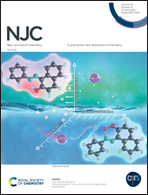Molybdenum phosphide nanoparticles encapsulated with biomolecule-derived N, P-codoped carbon nanosheets for the synergistic hydrogen evolution reaction†
Abstract
Molybdenum phosphide (MoP) is recognized as one of the most promising catalysts for the hydrogen evolution reaction (HER); however the low electronic conductivity and complicated synthesis process still restrict its commercialization as a replacement for the benchmark Pt/C catalyst. Herein, a novel type of MoP nanoparticles encapsulated with biomolecule-derived N, P-codoped carbon nanosheets has been successfully fabricated by a simple one-step pyrolysis of ammonium molybdate tetrahydrate, 1-hydroxyethylidene diphosphonic acid (HEDP) and a unique biomolecule guanine as the precursor of two-dimensional carbon materials. Benefiting from the well-designed architecture with both good electronic conductivity and easily accessible catalytic sites provided by the 2D carbon structure, the optimized catalyst exhibits synergistically enhanced HER activity under both alkaline and acidic conditions, especially with a low overpotential of 104 mV to deliver 10 mA cm−2 in 1 M KOH. Moreover, the coverage of N, P-codoped graphene-like carbon layers can prevent the corrosion of MoP nanoparticles in harsh reaction media, ensuring superior durability. This work has opened up a new direction for further development of simple, low-cost but efficient novel electrocatalysts.



 Please wait while we load your content...
Please wait while we load your content...